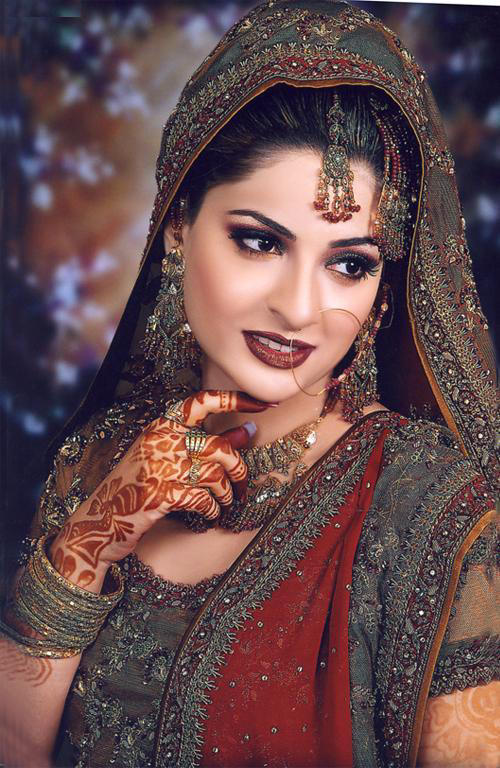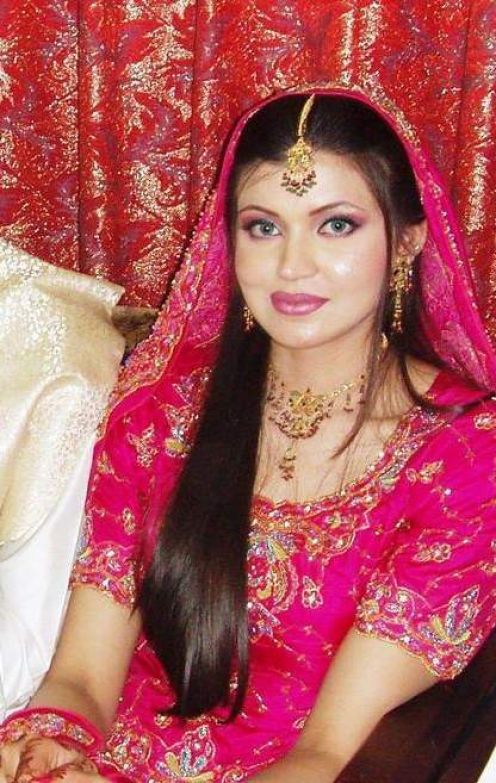Bridal Dresses Pakistani Definition
Source(google.com.pk)
The function of Indian wedding outfits is not only to clothe the bride, groom and other participants, but to celebrate and rejoice in the wedding and the couple. Guests to a traditional Indian wedding should wear traditional outfits with bright colors to show their support for the couple and join in wishing the couple good luck and a happy future.
Considerations
Guests to a traditional Indian wedding should not wear certain colors so as not to conflict with the cultural traditions of the wedding. At an Indian wedding, a guest should not wear red. The bride wears red and the guest should not take attention away from the bride. Culturally, wearing all black or all white corresponds with grief, death and mourning, so these colors should not be worn at a wedding. Guests should try to wear traditional Indian outfits, and should avoid tight and promiscuous clothing. Female guests should bring a dupetta or scarf to cover themselves if they will be in a religious building.
Geography
Throughout India, there may be different styles for wedding attire. Traditional Indian weddings that occur in other countries, such as the United States, may also vary in attire from what is worn in India. The final choices for wedding attire rest with the bride and groom.
Indian weddings are steeped in tradition. Because of this, Indian brides choose wedding color schemes based on the ideas they represent. Red is the most traditional color at Indian weddings. Gold and other bright colors are also popular choices. Whether you choose red, gold or other colors for your wedding, choosing bright colors will reflect the joyful feeling important at Indian weddings.
In Indian tradition, the color red signifies purity, joy and celebration. Indian culture considers red the color of happiness and prosperity and believes red attracts good luck. For these reasons, Indian brides traditionally wear red at their weddings. Brides wishing for an unconventional color scheme choose other bright colors for their wedding gowns, but red is the favored color for most brides. Use red on wedding invitations to set the celebratory tone.
Gold
Gold provides a rich complement to red wedding decor. The combination of gold and red represents wealth and good fortune and provides a dramatic color scheme for wedding activities. Consider draping gold and yellows fabric throughout the wedding location. The draping will brighten the space, and the bride's red gown will take center stage. Typical Indian weddings include flowers in shades of gold as well as other bright colors.
Other Colors
Tone down the warm reds and golds of your wedding gown with accents in cooler colors. Teal blue, white, silver, and various pinks complement the fiery red hues used elsewhere in your wedding color scheme. These bright jewel tones look beautiful paired with dark complexions and hair. Decorate the space with flowers in bright hues that look good with other colors in the wedding scheme. Bright pink is another popular choice for dresses and flowers. Grooms traditionally wear white.
Marriage is the secure institution for the perpetuation of the species and also for maintaining the property granting rights. In India, arranged marriages are the centuries old tradition dating back to the fourth century. The culture of arranged marriage is considered as a foundation stone of the Indian marriage system. In ancient times, the marriages often took place at the time when bride and groom were in their adolescence age. The boy’s parents searched for a suitable girl with the help of middlemen and approached the girl’s parents with proposition. The middlemen or negotiator suggested suitable date and hour of marriage according to the birth charts of the couple. In that era, generally marriages took place at the hometown of the girl and bride’s family acts as a host for the groom’s family.
Certain references to the polygamy and polyandry are visible in Hindu marriages because of various political as well as social reasons. At that time, falling in love before marriage was more than a crime; still, we can find the traces of affectionate relationships between princes and princesses.
The tradition of ‘Swayamvars’ arranged by the kings for their daughters came into existence in the middle ages. During that era, ‘swayamvars’ were considered a modern way of choosing grooms on the basis of their abilities and also provided brides a chance to make their own choice.
The right of selecting bride and groom for both men and women has gone through a period of transition due to social changes, wars, diversity in cultures etc. Later on marriages turned into materialistic deals with the emergence of dowry system. The dignity of women was lost and she became just another commodity to be exchanged in lieu of social and moral burden on her family. References to the marriages in ancient texts clearly suggest that the Aryans were monogamous.
You can also find traces of polygamy and polyandry in the Mahabharata, the Hindu epic. Marriage was compulsory for all girls in medieval India; however, the girls opted for asceticism is exception. Polygamy was popular among the ‘Kshatriyas’.
Child marriage was not prevalent in ancient India, but became a common phenomenon in the medieval age because of political anarchy at that time. The prevailing modernization and globalization has changed the status of women in the society, which has brought the revolution against the mal practices with women in the name of marriage.
It was a common belief that the women has to stay with grooms family after marriage, although, some couples prefer to live alone. Groom was supposed to look after the needs of the bride for the rest of the life.
The selection of the couple was generally based on Shastric ideas, according to which, the bride’s parents not only searched for good deeds in the boy but also considered his family, education, social behavior, etc. The custom of Indian marriage has gone through tremendous change, but the essence of this tradition is still the same. This sacred institution is made for binding the two souls together for the life time
Bridal dresses Pakistani


Bridal dresses Pakistani
 Bridal dresses Pakistani
Bridal dresses Pakistani


Bridal dresses Pakistani
 Bridal dresses Pakistani
Bridal dresses Pakistani



Bridal dresses Pakistani
 Bridal dresses Pakistani
Bridal dresses Pakistani
 Bridal dresses Pakistani
Bridal dresses Pakistani




Bridal dresses Pakistani


Bridal dresses Pakistani


Bridal dresses Pakistani
.
No comments:
Post a Comment